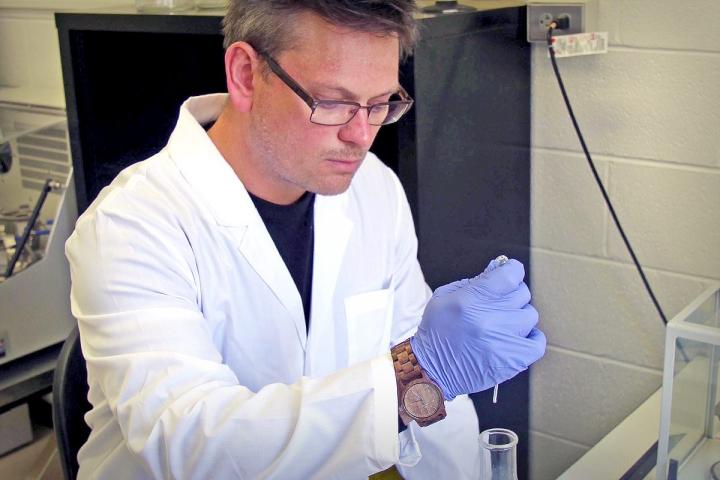
Credit: Virginia Tech.
The Bay Area Lyme Foundation, the leading not-for-profit sponsor of Lyme disease research in the United States, recently announced its three recipients of the 2021 Emerging Leader Awards, including Brandon Jutras, an assistant professor of biochemistry in the Virginia Tech College of Agriculture and Life Sciences and an expert in Lyme disease pathogenesis.
The awards are designed to support established and up-and-coming scientists who have identified new and defined approaches to improve diagnostics or therapeutics for Lyme disease.
Jutras and his lab are in the midst of developing a new direct-detection diagnostic for Lyme disease.
“I was thrilled and honored to receive the Emerging Leader Award from the Bay Area Lyme Foundation,” Jutras said. “The organization has a long-standing tradition of funding impactful research with the goal of improving Lyme disease diagnostics and treatment options. Our studies align with their mission, and we’re fortunate to embark on this fantastic partnership together.”
Over the past two decades, the United States has experienced a dramatic increase in both the number of reported cases and the geographic distribution of Lyme disease. In the state of Virginia, the disease is transmitted by the bite of blacklegged ticks, which are infected with the Lyme disease-causing bacterium Borrelia burgdorferi.
In 2019, Jutras discovered that Borrelia burgdorferi sheds peptidoglycan, a mesh-like substance that forms the cell wall of the bacteria, once it invades the human body. Although all bacteria have peptidoglycan, many do not shed the substance.
Since virtually no other bacteria have peptidoglycan quite like Borrelia burgdorferi, the substance is as unique as a fingerprint, making it an attractive biomarker for diagnostics. Biomarkers are unique molecular signatures, like flags, that act as an indicator that something has gone awry in a system. They are often used to diagnose different forms of cancer.
According to estimates from the Bay Area Lyme Foundation, more than 1 million Americans may be suffering from the impact of its debilitating long-term symptoms and complications, like Lyme arthritis.
If caught early, most cases of Lyme disease can be effectively treated, but it is commonly misdiagnosed due to lack of awareness and, most importantly, unreliable indirect diagnostic tests – which makes Jutras’ development of novel diagnostics a critical need.
“Current Lyme disease diagnostics are indirect, meaning that the tests are detecting antibodies produced by the human in response to the infection, rather than detecting the bacteria itself,” said Jutras, an affiliated faculty member of Virginia Tech’s Center for Emerging, Zoonotic, and Arthropod-borne Pathogens, housed within the Fralin Life Sciences Institute. “This method is prone to error and relies on the individual’s immune system, which can take weeks to make enough antibodies to detect, not to mention that everyone’s immune system is different.”
With a new, more-direct diagnostic approach, doctors could catch Lyme disease sooner rather than later, which means that patients could avoid contracting the most debilitating of symptoms.
For his new direct diagnostic, Jutras will be using peptidoglycan as a biomarker for acute Lyme disease.
“We are trying to develop and critically test a procedure whereby we detect peptidoglycan, which is a unique piece of the bacterium that causes Lyme disease,” said Jutras. “The piece is a specific and abundant fragment that may act as a direct biomarker for an active infection and, in theory, be detectable within hours of transmission from an infected tick.”
Jutras is one of two award winners who will be using biological samples from the Lyme Disease Biobank, a program of the Bay Area Lyme Foundation, to collect human tissue, blood and urine specimens to better understand tick-borne diseases and develop improved tests and therapeutics.
“The Lyme Biobank is a well-characterized collection of human patient samples collected from folks at different disease stages,” said Jutras. “This is a fantastic resource that we will use to critically test our direct diagnostic efforts.”
“This year’s applicants offered some of the most innovative ideas for overcoming the challenges of Lyme disease and present great inspiration across all areas of tick-borne disease,” said Wendy Adams, the research grant director of Bay Area Lyme. “Developing sensitive diagnostics and effective therapeutics should be the highest priority in Lyme disease research. We look forward to the outcomes of this promising research, as well as the other research that we expect these projects to inspire.”
Jutras says that not-for-profit organizations like the Bay Area Lyme Foundation play a key role in providing resources to tackle challenging problems.
“Not-for-profit organizations, like the Bay Area Lyme Foundation, play an essential role in advancing problem areas forward by funding studies that may be considered too risky for federal agencies,” Jutras said. “Without them, we are not afforded the opportunity try multiple ways to tackle complex problems, opportunities that may just lead to big breakthroughs.”
Other recipients of this year’s Emerging Leader Awards are Michael P. Rout, a professor at The Rockefeller University, and Nitya Ramadoss, a research scientist at the Stanford University School of Medicine.
If you want to keep in touch with the three recipients of the 2021 Emerging Leader Awards and their research, you can listen to the Bay Area Lyme Ticktective podcast in the coming months.
###
About Bay Area Lyme Foundation
Bay Area Lyme Foundation, a national organization committed to making Lyme disease easy to diagnose and simple to cure, is the leading public not-for-profit sponsor of innovative Lyme disease research in the U.S. A 501c3 nonprofit organization based in Silicon Valley. Bay Area Lyme Foundation collaborates with world-class scientists and institutions to accelerate medical breakthroughs for Lyme disease. It is also dedicated to providing reliable, fact-based information so that prevention and the importance of early treatment are common knowledge. For more information about Lyme disease or to get involved, visit http://www.
Media Contact
Kendall Daniels
[email protected]
Original Source
https:/




